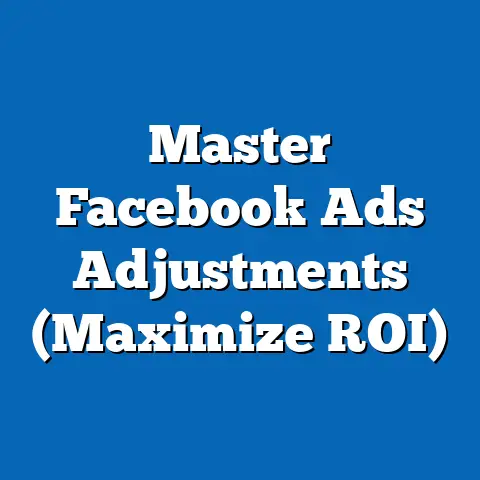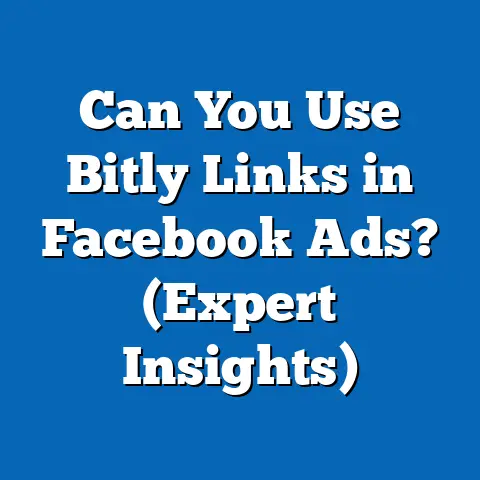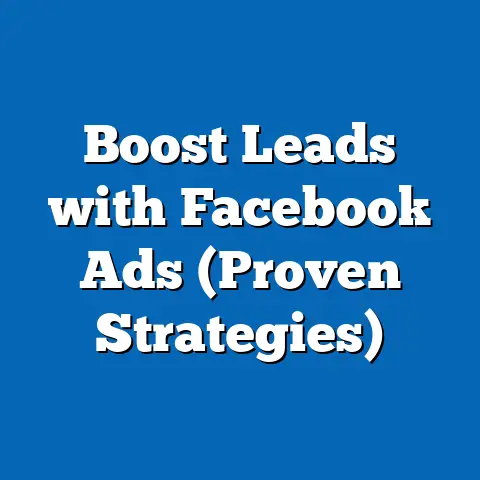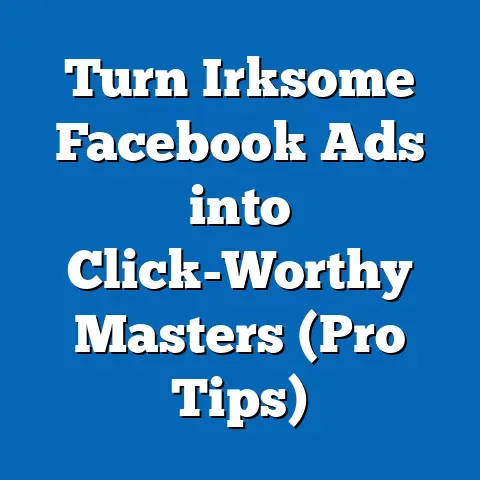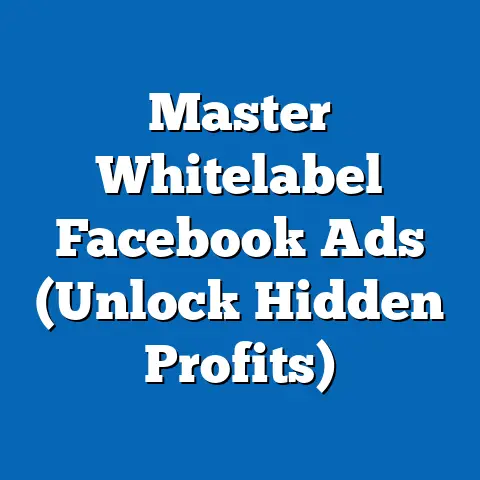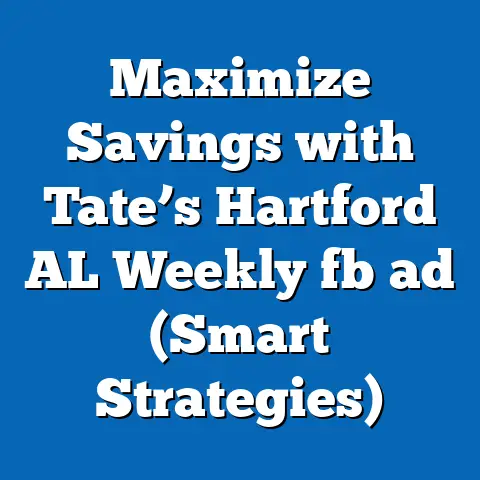Discover Facebook Ads by People (Proven Strategies Inside)
Facebook, now Meta, is more than just a social network; it’s a powerhouse for advertising. I remember when I first started using Facebook Ads, I was skeptical. Could a social media platform really drive significant business results? The answer, unequivocally, is yes.
With billions of active users, Facebook offers unparalleled reach. What’s more, the platform’s sophisticated targeting capabilities allow you to pinpoint your ideal customers with laser-like precision. I once worked with a local bakery that struggled to attract new customers. By using Facebook Ads to target people interested in baking, desserts, and local events, we saw a 30% increase in foot traffic within just a few weeks.
Consider these statistics:
- User Base: Facebook has nearly 3 billion monthly active users. That’s a massive audience waiting to be tapped into.
- Engagement: The average user spends significant time on the platform daily, increasing the chances of your ad being seen.
- Targeting: Facebook’s advanced targeting options allow you to reach specific demographics, interests, behaviors, and more.
- Conversion Rates: Studies show that Facebook ads can achieve impressive conversion rates, especially when combined with retargeting strategies.
Whether you’re a small startup or a large corporation, Facebook Ads can provide a cost-effective way to reach your target audience, drive traffic, generate leads, and increase sales.
Takeaway: Facebook Ads are essential for businesses of all sizes. The platform’s vast user base and advanced targeting capabilities offer unparalleled opportunities for growth.
Understanding the Facebook Ads Ecosystem
Navigating the Facebook Ads ecosystem can feel like entering a new world. But once you understand the key components, it becomes much more manageable. Let’s break it down:
Advertising Objectives
Facebook offers a range of advertising objectives tailored to different business goals. These objectives fall into three main categories:
- Awareness: These objectives aim to increase brand recognition and reach. Examples include Brand Awareness and Reach.
- Consideration: These objectives focus on engaging your audience and driving them to learn more about your business. Examples include Traffic, Engagement, App Installs, Video Views, and Lead Generation.
- Conversion: These objectives are designed to drive specific actions, such as purchases, sign-ups, or form submissions. Examples include Conversions, Catalog Sales, and Store Traffic.
I remember when I was launching a new e-commerce store. Initially, I focused on the “Traffic” objective to drive visitors to my website. However, I quickly realized that many of these visitors weren’t converting. By switching to the “Conversions” objective and optimizing my ads for purchases, I saw a significant increase in sales.
Ad Formats
Facebook offers a variety of ad formats to suit different marketing goals and creative approaches:
- Image Ads: Simple and effective, image ads are great for showcasing products or services with a compelling visual.
- Video Ads: Engaging and dynamic, video ads can capture attention and tell a story.
- Carousel Ads: These ads allow you to display multiple images or videos in a scrollable format, perfect for showcasing a range of products or features.
- Slideshow Ads: Similar to video ads, slideshow ads combine multiple images with transitions and music to create an engaging experience.
- Collection Ads: Designed for e-commerce, collection ads allow users to browse and purchase products directly from the ad.
I once created a carousel ad for a clothing store, highlighting different outfits for the season. The ad performed exceptionally well, with users clicking through to view and purchase each item.
Ad Placements
Facebook Ads can appear in various placements across the Facebook ecosystem:
- Facebook Feed: The most common placement, appearing directly in users’ news feeds.
- Instagram Feed: Another popular placement, reaching users on Instagram.
- Facebook Stories: Short-form video or image ads that appear between users’ Stories.
- Instagram Stories: Similar to Facebook Stories, but on Instagram.
- Facebook Marketplace: Ads that appear in the Facebook Marketplace, targeting users actively looking to buy or sell items.
Facebook Ads Manager
The Facebook Ads Manager is your central hub for creating, managing, and analyzing your ad campaigns. It provides a user-friendly interface for setting up campaigns, defining your target audience, choosing ad placements, setting your budget, and tracking your results.
I highly recommend familiarizing yourself with the Ads Manager. It’s the key to unlocking the full potential of Facebook advertising.
Facebook Pixel
The Facebook Pixel is a piece of code that you place on your website to track user behavior. It allows you to:
- Track Conversions: See which ads are driving the most valuable actions on your website, such as purchases or sign-ups.
- Retarget Website Visitors: Show ads to people who have previously visited your website, reminding them of your products or services.
- Create Lookalike Audiences: Find new customers who are similar to your existing customers, expanding your reach and improving your targeting.
The Facebook Pixel is a game-changer. Without it, you’re essentially flying blind. Make sure to install it correctly and use it to track and optimize your campaigns.
Takeaway: Understanding the Facebook Ads ecosystem is crucial for creating effective campaigns. Choose the right objectives, ad formats, and placements to align with your business goals.
Proven Strategies for Successful Facebook Ads
Now, let’s dive into some proven strategies that I’ve used to achieve success with Facebook Ads.
Strategy 1: Targeting the Right Audience
Targeting is the foundation of any successful Facebook Ads campaign. If you’re showing your ads to the wrong people, you’re wasting your time and money.
Facebook offers a range of targeting options:
- Demographics: Target users based on age, gender, education, location, and more.
- Interests: Target users based on their interests, hobbies, and pages they’ve liked.
- Behaviors: Target users based on their online behavior, such as purchase history or device usage.
- Custom Audiences: Target users who have previously interacted with your business, such as website visitors, email subscribers, or app users.
- Lookalike Audiences: Target new users who are similar to your existing customers, based on shared characteristics and behaviors.
I once worked with a fitness studio that struggled to attract new members. By creating a custom audience of people who had visited their website and a lookalike audience based on their existing members, we were able to significantly increase their membership sign-ups.
Example:
- Business: A local coffee shop.
- Target Audience: People who live within a 5-mile radius, are interested in coffee, local events, and support local businesses.
- Ad Copy: “Start your day with the best coffee in town! Visit [Coffee Shop Name] for a delicious brew and a friendly atmosphere.”
Takeaway: Precise targeting is key to reaching the right audience and maximizing your ad spend. Experiment with different targeting options to find what works best for your business.
Strategy 2: Crafting Engaging Ad Creatives
Your ad creative is what captures people’s attention and motivates them to take action. It’s crucial to create visually appealing and compelling ads that resonate with your target audience.
Here are some tips for crafting engaging ad creatives:
- Use High-Quality Visuals: Choose images or videos that are clear, attractive, and relevant to your product or service.
- Write Compelling Copy: Use persuasive language that highlights the benefits of your offer and creates a sense of urgency.
- Include a Clear Call-to-Action (CTA): Tell people exactly what you want them to do, such as “Shop Now,” “Learn More,” or “Sign Up.”
- Keep it Concise: Get straight to the point and avoid overwhelming your audience with too much information.
- Test Different Variations: Experiment with different visuals, copy, and CTAs to see what performs best.
I once ran an ad campaign for a travel agency, showcasing stunning photos of exotic destinations. The ads were visually appealing, but they didn’t include a clear CTA. By adding a “Book Now” button, we saw a significant increase in click-through rates and bookings.
Example:
- Business: An online clothing store.
- Visual: A high-quality image of a model wearing the store’s latest outfit.
- Ad Copy: “Get ready for summer with our new collection! Shop now and enjoy 20% off your first order.”
- CTA: “Shop Now”
Takeaway: Your ad creative is your first impression. Make it count by using high-quality visuals, compelling copy, and clear CTAs.
Strategy 3: A/B Testing and Optimization
A/B testing, also known as split testing, is the process of comparing two versions of an ad to see which one performs better. It’s a crucial part of optimizing your Facebook Ads campaigns.
Here’s how to conduct A/B testing:
- Choose a Variable to Test: Select one element of your ad to test, such as the headline, image, or CTA.
- Create Two Versions: Create two versions of your ad, each with a different variation of the chosen variable.
- Run the Test: Run the ads simultaneously and track their performance.
- Analyze the Results: Determine which version performed better based on metrics such as click-through rate, conversion rate, and cost per acquisition.
- Implement the Winner: Use the winning variation in your future ad campaigns.
I once A/B tested two different headlines for an ad campaign promoting a webinar. One headline focused on the benefits of attending the webinar, while the other focused on the pain points that the webinar would address. The headline that focused on pain points performed significantly better, driving more sign-ups.
Example:
- Variable to Test: Headline.
- Version A: “Learn How to Boost Your Sales with Facebook Ads”
- Version B: “Struggling to Get Sales with Facebook Ads? We Can Help”
Takeaway: A/B testing is essential for optimizing your Facebook Ads campaigns. Continuously test different elements to identify what works best for your audience.
Strategy 4: Leveraging Retargeting Campaigns
Retargeting is the process of showing ads to people who have previously interacted with your business, such as website visitors or app users. It’s a highly effective way to re-engage potential customers and increase conversion rates.
Here’s how to leverage retargeting campaigns:
- Install the Facebook Pixel: Make sure the Facebook Pixel is installed on your website to track visitor behavior.
- Create Custom Audiences: Create custom audiences based on website visitors, email subscribers, or app users.
- Craft Targeted Ads: Create ads that are specifically tailored to the audience you’re retargeting.
- Offer Incentives: Consider offering discounts or special offers to encourage people to take action.
I once ran a retargeting campaign for an e-commerce store, showing ads to people who had added items to their cart but didn’t complete the purchase. By offering a 10% discount, we were able to recover a significant number of abandoned carts and increase sales.
Example:
- Target Audience: People who have visited the product page on your website but didn’t add the item to their cart.
- Ad Copy: “Still thinking about it? Get 10% off [Product Name] when you purchase today!”
- CTA: “Shop Now”
Takeaway: Retargeting is a powerful tool for re-engaging potential customers and increasing conversion rates. Use it to remind people of your products or services and encourage them to take action.
Case Studies of Successful Facebook Ad Campaigns
To illustrate these strategies in action, let’s look at a couple of case studies.
Case Study 1: Local Restaurant
- Challenge: A local restaurant wanted to increase its lunch crowd.
- Strategy: They created a Facebook Ad campaign targeting people within a 5-mile radius who were interested in food, dining, and local events. They ran image ads showcasing their delicious lunch specials and offered a 10% discount for first-time customers.
- Results: The restaurant saw a 25% increase in lunch customers within the first month of running the campaign.
- Lesson Learned: Hyperlocal targeting and attractive offers can drive significant results for local businesses.
Case Study 2: Online Education Platform
- Challenge: An online education platform wanted to increase sign-ups for their courses.
- Strategy: They created a Facebook Ad campaign targeting people interested in online learning, career development, and specific course topics. They ran video ads showcasing testimonials from successful students and offered a free trial for new users.
- Results: The platform saw a 40% increase in course sign-ups within the first two months of running the campaign.
- Lesson Learned: Video testimonials and free trials can be highly effective for driving sign-ups for online education platforms.
Takeaway: These case studies demonstrate the power of Facebook Ads when used strategically. By understanding your target audience, crafting engaging creatives, and leveraging retargeting, you can achieve significant results.
Common Mistakes to Avoid in Facebook Advertising
Even with the best strategies, it’s easy to make mistakes with Facebook Ads. Here are some common pitfalls to avoid:
- Poor Audience Targeting: Targeting too broad an audience can lead to wasted ad spend and poor results.
- Solution: Use Facebook’s targeting options to narrow down your audience and reach the right people.
- Neglecting Mobile Optimization: Many Facebook users access the platform on their mobile devices.
- Solution: Ensure your ads are optimized for mobile viewing, with clear visuals and concise copy.
- Failing to Track Conversions: Without tracking conversions, you won’t know which ads are driving the most valuable actions.
- Solution: Install the Facebook Pixel on your website and track conversions to optimize your campaigns.
- Ignoring Ad Fatigue: Showing the same ads to the same audience for too long can lead to ad fatigue and decreased performance.
- Solution: Rotate your ad creatives regularly to keep your audience engaged.
- Not Monitoring Performance: Failing to monitor your ad performance can lead to wasted ad spend and missed opportunities.
- Solution: Regularly check your ad metrics and make adjustments as needed to optimize your campaigns.
- Solution: Use Facebook’s targeting options to narrow down your audience and reach the right people.
- Solution: Ensure your ads are optimized for mobile viewing, with clear visuals and concise copy.
- Solution: Install the Facebook Pixel on your website and track conversions to optimize your campaigns.
- Solution: Rotate your ad creatives regularly to keep your audience engaged.
- Solution: Regularly check your ad metrics and make adjustments as needed to optimize your campaigns.
Takeaway: Avoiding these common mistakes can significantly improve the effectiveness of your Facebook Ads campaigns. Stay vigilant and continuously optimize your approach based on performance data.
Conclusion
Facebook Ads are a powerful tool for businesses looking to reach a vast audience, drive traffic, generate leads, and increase sales. By understanding the Facebook Ads ecosystem, implementing proven strategies, and avoiding common mistakes, you can unlock the full potential of this platform.
Remember, Facebook advertising is an ongoing process. Continuously learn, adapt, and optimize your approach based on performance data.
As Neil Patel once said, “Content is king, but marketing is queen and runs the household.” And in today’s digital world, Facebook Ads are a crucial part of that marketing strategy. So, go out there, experiment, and discover what works best for your business. The possibilities are endless!

